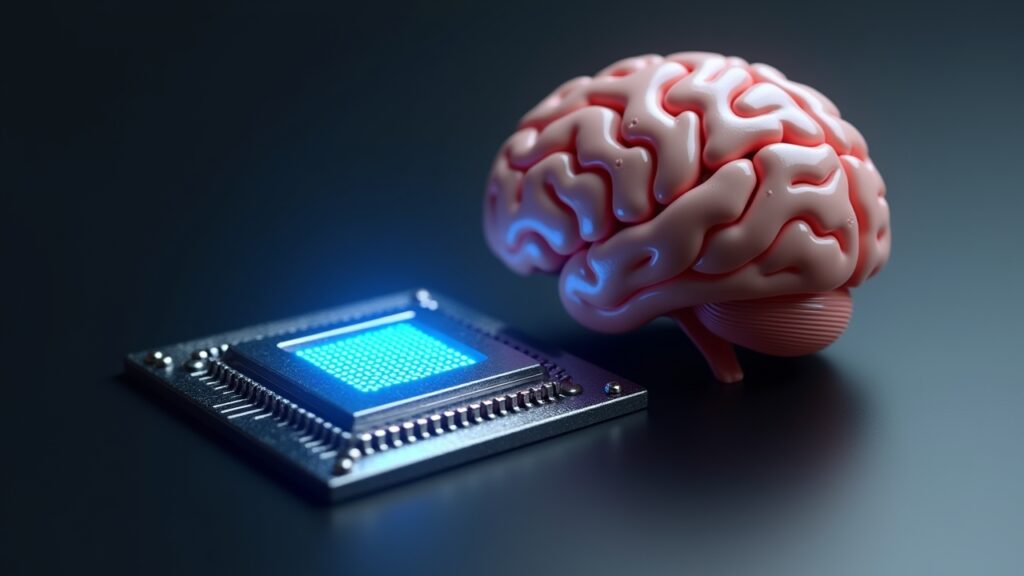Advertisements
Did you know that the human brain uses about as much power as a 20-watt light bulb? Meanwhile, training a single AI model can consume as much electricity as five cars do in their entire lifetime! I first stumbled onto neuromorphic computing when my laptop nearly melted trying to run a basic neural network simulation back in 2019.
Let me tell you, discovering brain-inspired chips was like finding out there’s a secret passage in your own house. These fascinating pieces of silicon are literally designed to mimic how our neurons work. And trust me, once you understand what they can do, you’ll never look at computing the same way again.
What Exactly Are Neuromorphic Chips?

Okay, so imagine if your computer’s processor worked like your brain instead of like a calculator on steroids. That’s basically what neuromorphic chips do. They process information using artificial neurons and synapses that fire and communicate just like the ones in your noggin.
Traditional processors work sequentially – they do one thing, then another, then another. It’s like reading a recipe step by step. But neuromorphic processors? They’re more like a jazz band where everyone’s playing at once but somehow it all comes together beautifully.
The first time I got my hands on Intel’s Loihi chip at a tech conference, I was blown away. This thing could learn patterns in real-time without being explicitly programmed! Intel’s neuromorphic research shows these chips can be up to 1000 times more energy efficient than conventional processors for certain tasks.
How Do These Brain-Like Processors Actually Work?
Here’s where it gets really cool. Instead of using traditional binary logic (you know, the whole 1s and 0s thing), neuromorphic chips use something called spiking neural networks. These networks communicate through electrical pulses, or “spikes,” just like biological neurons do.
I remember trying to explain this to my nephew last Thanksgiving. I told him it’s like the difference between sending morse code messages (traditional computing) versus having an actual conversation (neuromorphic computing). One’s rigid and sequential, the other’s dynamic and parallel.
The architecture includes these key components:
- Artificial neurons that accumulate input signals
- Synapses that connect neurons and can strengthen or weaken over time
- Event-driven processing that only activates when needed
- Asynchronous operation (no central clock telling everything when to tick)
Real-World Applications That’ll Blow Your Mind
You wouldn’t believe some of the stuff these chips are already doing. IBM’s TrueNorth chip is being used in everything from smartphone cameras to self-driving cars. IBM’s neuromorphic technology can process sensory data with incredible efficiency.
Last month, I visited a robotics lab where they were using neuromorphic sensors for prosthetic limbs. The response time was insane – practically instantaneous! These chips can process touch sensations and movement commands faster than traditional processors because they don’t need to convert analog signals to digital and back again.
Some other mind-blowing applications include:
- Smart cameras that can recognize objects using minimal power
- Drones that navigate autonomously without GPS
- Medical devices that can detect seizures before they happen
- Edge AI devices that learn and adapt without cloud connectivity
The Challenges (Because Nothing’s Perfect, Right?)
Now, I gotta be honest with you – neuromorphic computing isn’t all sunshine and rainbows. Programming these chips is tough. Like, really tough. Traditional coding languages don’t really work here because you’re dealing with probabilistic, event-driven systems instead of deterministic ones.
I spent three weeks trying to implement a simple pattern recognition algorithm on a neuromorphic platform. Three weeks! For something that would’ve taken me an afternoon on a regular processor. The learning curve is steep, and the tools are still pretty primitive compared to what we have for conventional computing.
Plus, these chips aren’t great at everything. They excel at pattern recognition, sensory processing, and adaptive learning. But ask them to crunch numbers for your spreadsheet? You’re better off with your regular CPU.
Your Next Steps in the Neuromorphic Revolution
So where does this leave us regular folks who aren’t chip designers at Intel or IBM? Well, the neuromorphic revolution is coming whether we’re ready or not. These brain-inspired processors are gonna change how we interact with technology in ways we can’t even imagine yet.
If you’re curious about diving deeper, I’d suggest checking out some of the open-source neuromorphic simulators like NEST or Brian2. They’ll give you a taste of how these systems work without needing actual hardware. Fair warning though – it’s addictive once you start seeing how elegantly these systems solve complex problems!
The future of computing is looking more biological every day, and honestly, I find that both exciting and a little scary. But one thing’s for sure – neuromorphic chips are gonna be everywhere soon, from your smartphone to your smart home devices. Better to understand them now than be left wondering later! If you found this deep dive into brain-inspired computing fascinating, head over to Tech Digest for more cutting-edge tech explorations that’ll expand your digital horizons.




[…] as fascinated by the intersection of AI and privacy as I am, you’ll love exploring more cutting-edge tech topics on Tech Digest. We’re always diving deep into the technologies that are shaping our digital […]
[…] to dive deeper into the wild world of AI and emerging tech? Check out more mind-bending articles at Tech Digest. We’re always exploring the latest tech trends that’ll make you go […]